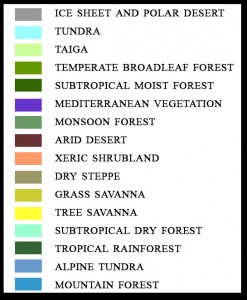One of the things I love about Game of Thrones is how it uses a wide reach of locations– both in story and in the filming. They shoot the show in Croatia, Ireland, Iceland, Morocco, and I don’t even know where else. One of the great things Martin has done in the books– and it translates onto the show– is paint a large canvas of different places and different environments, and letting those environments define the character of that part of the story.
Now, if you’re going to do this well, you need to do some research into biomes. Now, there are several different definitions for the different types of biomes, different systems to define said biomes. Most of these involve looking at the factors of temperature, moisture and elevation.
I’m partial to the definitions in my handy Biome Key, pictured here, and based off the World Wide Fund for Nature’s system. Figuring out what biome your story is set in will define the character of your story. Food, clothing and attitude of your people will all be drawn from the biome of their environment.
Now, some of these distinctions may seem trivial– how different is a Xeric Shrubland from an Arid Desert or a Subtropical Dry Forest? But having a strong understanding of exactly what the environment is like builds the verisimilitude of your worldbuilding.
And with that, of course, is the flora and fauna. Beyond the domesticated and edible ones, you have to think about how each of those exists in the environment. If you’re building something fantastical or science-fictional, give some consideration to the whole ecology. How do the different creatures survive their environment, especially if it’s harsh? What do they eat? What does what they eat eat? How does what they eat avoid getting eaten long enough to maintain a balance. You don’t want, say, an area filled with alpha predators and very little prey.
What biomes are you writing in, and how are you distinguishing it as a unique place for your story?

I’m writing a story during Victorian period in London mostly. However I don’t have it all in the streets, occasionally they go to the sewers and the like. But yeah, if you have it where your world is just sunshine or rain then it might as well be in a box. That always got me how the weather never changes in most stories unless the plot demands it. Of course there’s also the fact that half the stories are set somewhere in faux Western Europe.
Well I think the reason the weather isn’t really mentioned is there is little need to. Today’s reader wants the information now and we need to get right into the stories. Unless you have a good readership already. Then you should be good to go. Otherwise though, you need to focus on story and trying to stop and add what the weather is like each day your write is time consuming and if it isn’t important few will care. Though I often do add if it’s windy or cold, hot or cast over in how characters react to it. Otherwise though, apart to show passing of time., it isn’t needed. So it only comes up from time to time. I think that’s why most modern books don’t worry about it. Though I think the writer has to know those details for themselves, even if they can’t necessarily share it without dulling the audience.
Well, there is a difference between environment and weather, of course. And, yeah, you don’t want to bore your reader with detailed passages of the weather. But at the same time, how your characters engage their environment is often revealing. Is a sudden heavy downpour an unexpected inconvenience, or is it, “Oh, it’s four o’clock”?